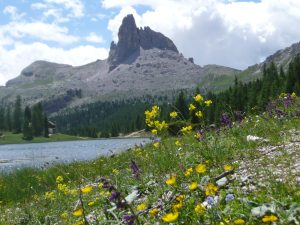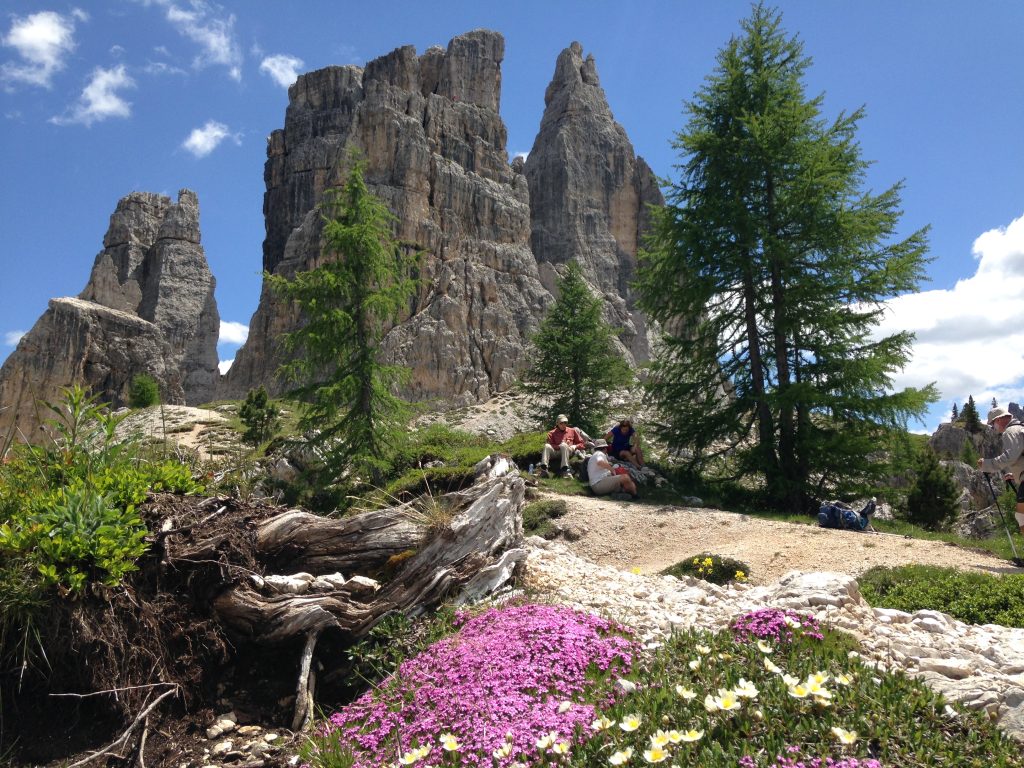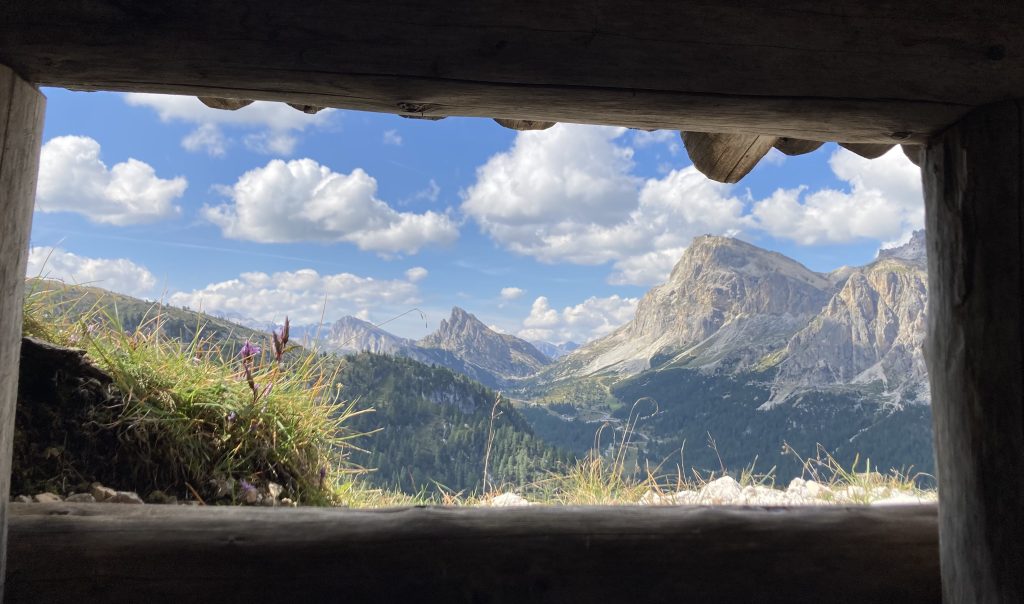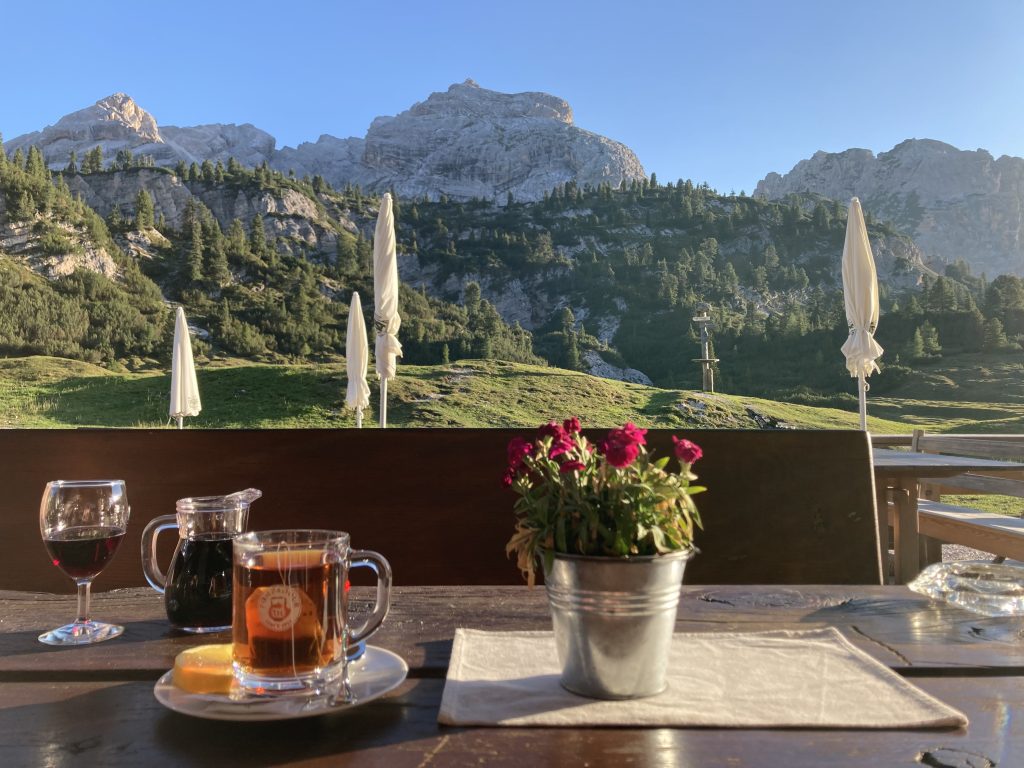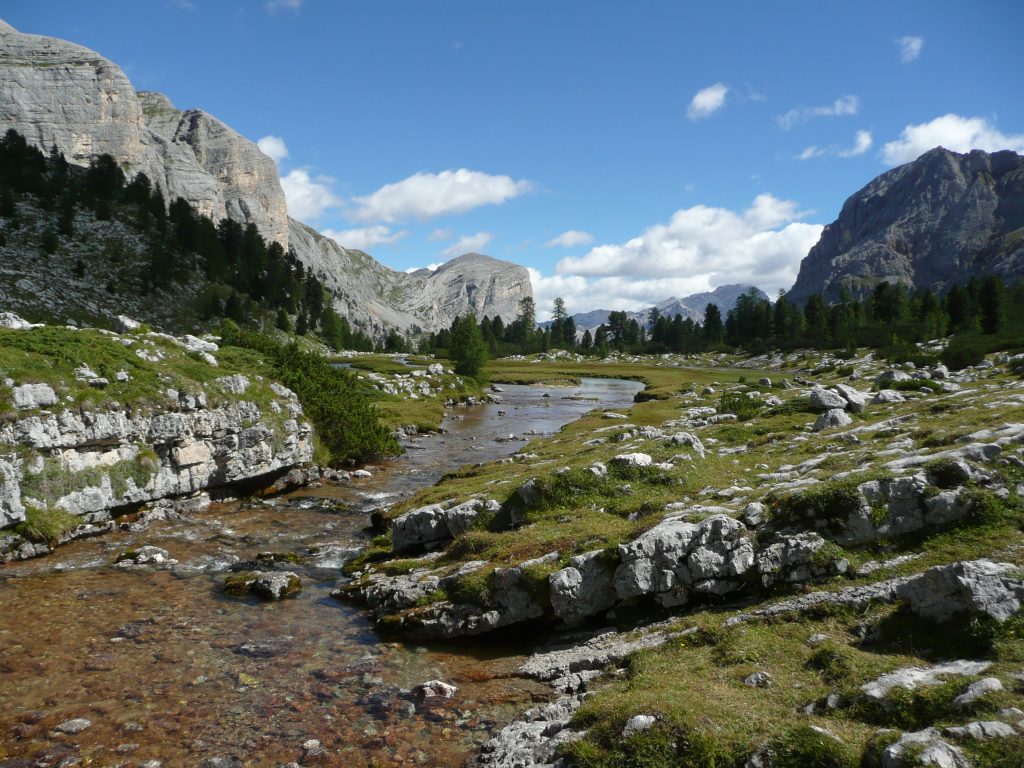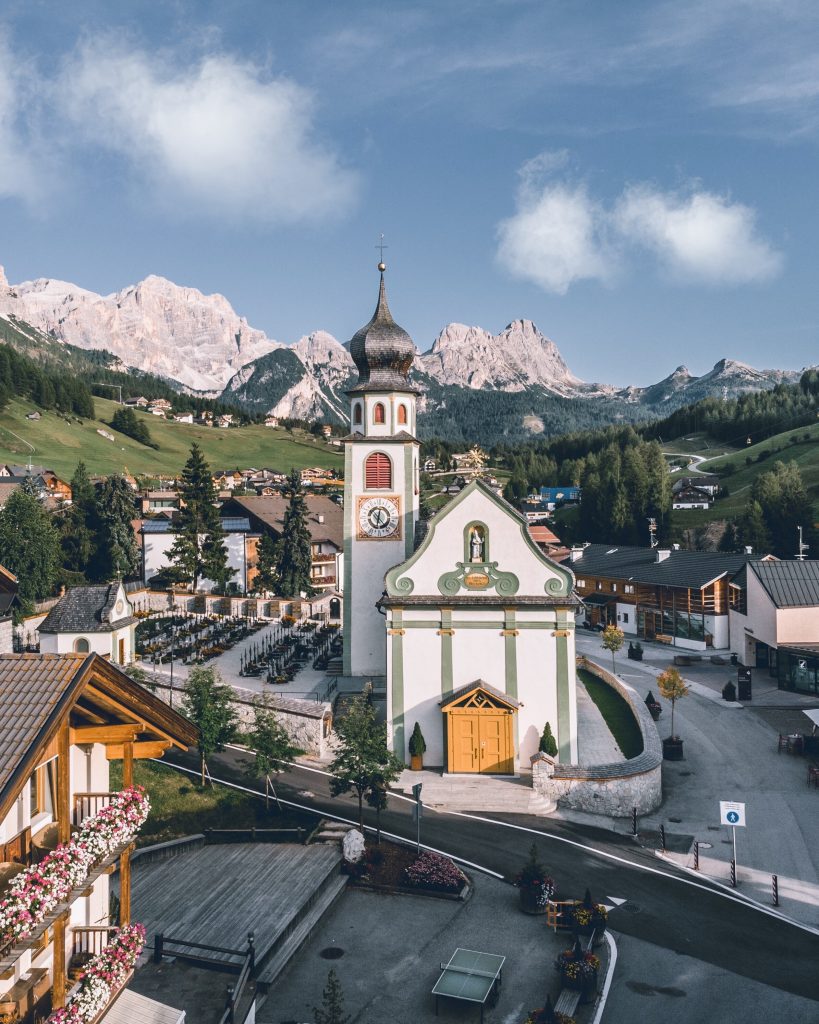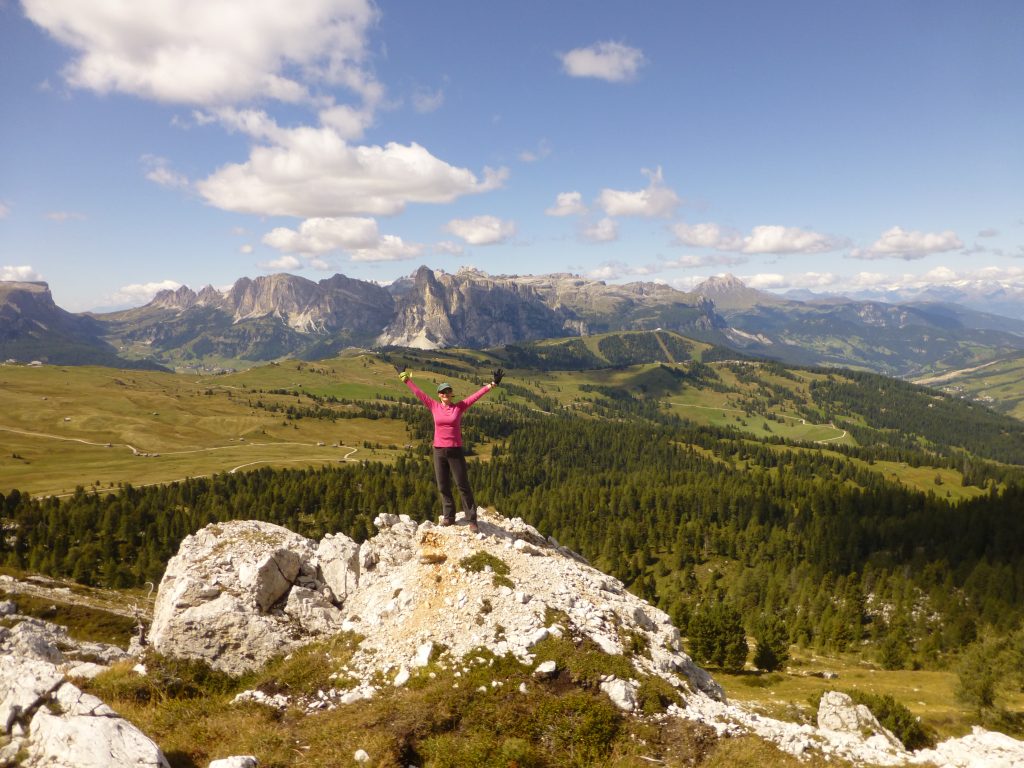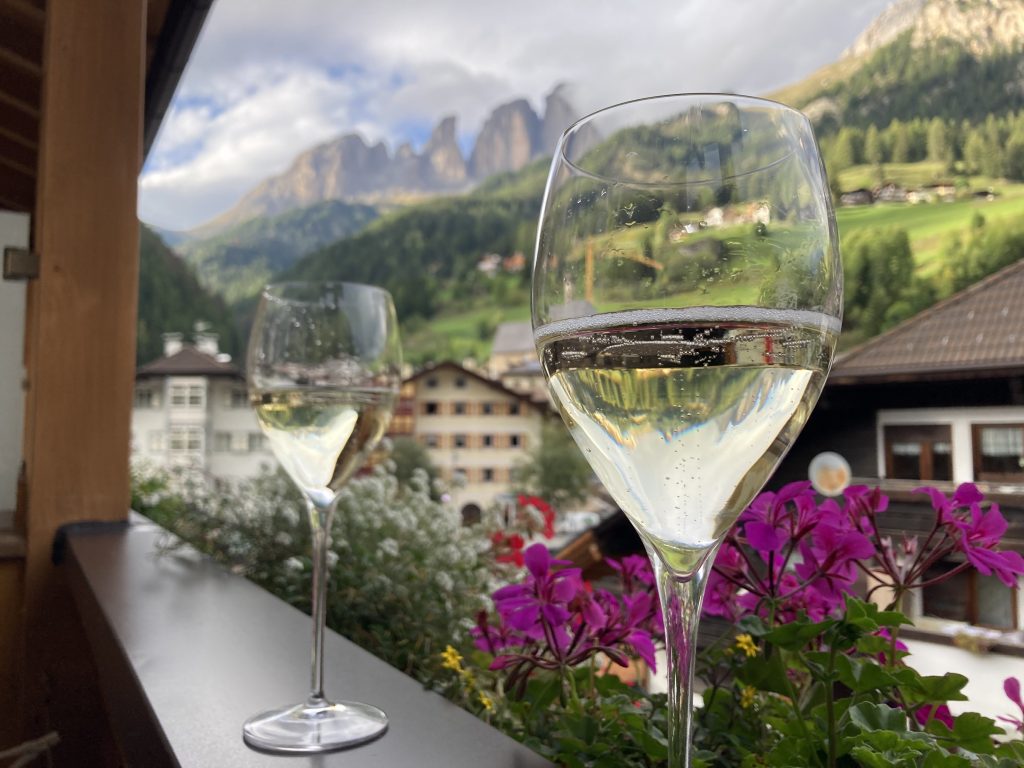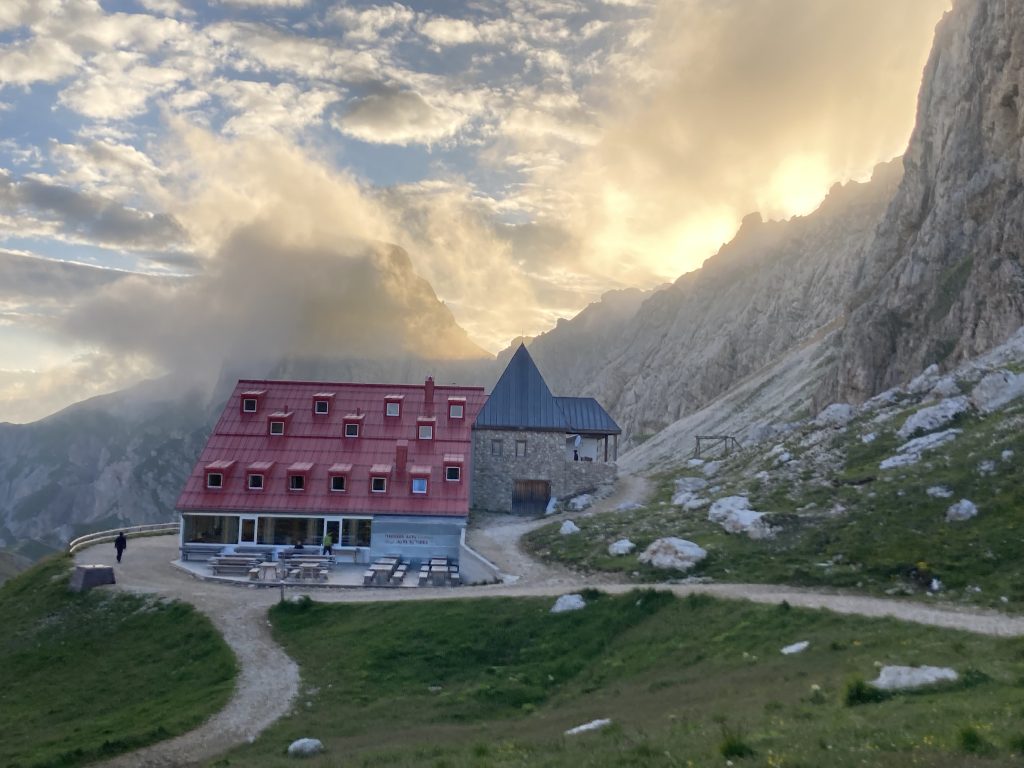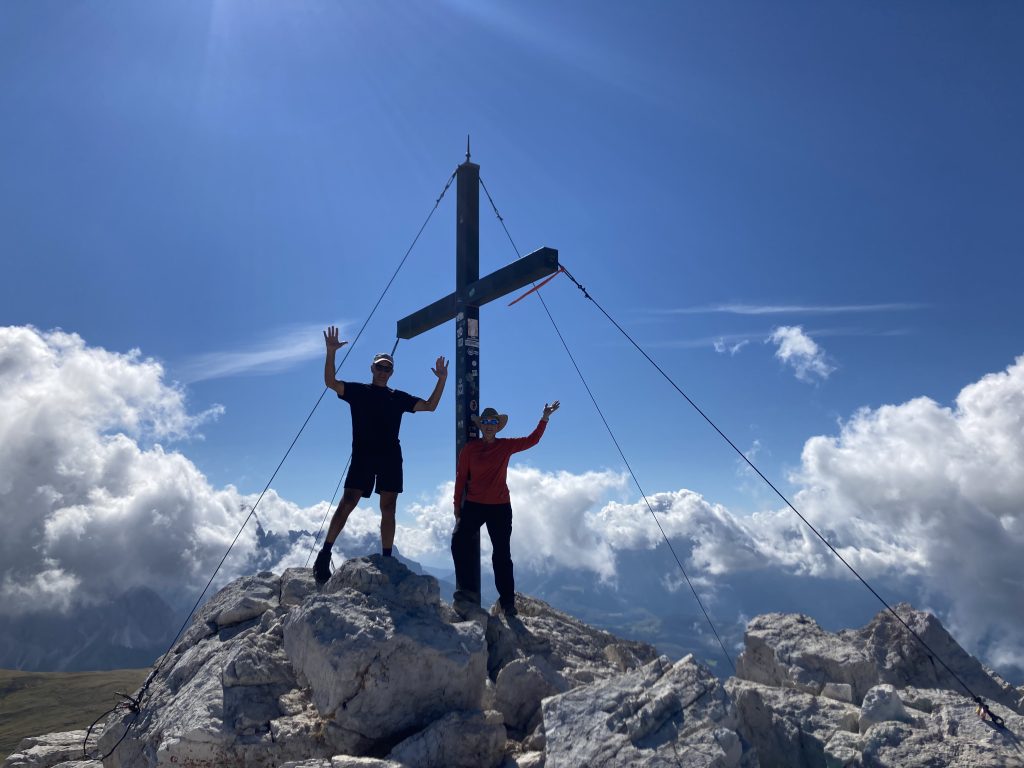23 Jan 23
One more for your wish list: Hiking the Dolomite mountains
No other hiking destination in the world can match the staggering beauty of Italy’s Dolomite mountains. They have to be seen to be believed! Here’s a peek into what to expect on our 13-day Dolomites Traverse, written by our lead guide for RAW’s European Alps trips.
Croda da Lago (Day 2)
The sun was shining and there was an air of excitement in the group this morning, knowing we were off on our trekking adventure. We were picked up by the ever-helpful Claudio, our local transport operator, who took our photo while we were still clean and keen! After a short 30-minute drive to the trailhead in the Cadore valley south of Cortina, it was time to don the rucksacks and start up the steep ascent to the Croda da Lago. Luckily, there was a nice rest spot, with fresh running water, partway up at a tiny woodcutter’s cabin.
Eventually the steep slope brought us to a tiny, picturesque lake at the foot of the rock walls of the Croda da Lago. After admiring the magnificent scenery, and taking lots of photos, the group were treated to a delicious refuge lunch. Usually we picnic at lunchtime, but this refuge spot was just too good to miss, and the local plates were delicious!
With full stomachs, we dragged ourselves away from this beautiful spot and started our descent to our hotel in the valley far below.
Cinque Torri (Day 3)
Today we were higher up and out of the forests, which give us magnificent views all round – including the Marmolada (the highest mountain in the Dolomites and the only one with a large glacier) in the distance. The paths were sometimes steep and rocky, and in one or two places required a hand hold. The group coped admirably and particularly enjoyed the tiny alpine flowers clinging to the limestone rocks.
We picnicked at the foot of the impressive Cinque Torri rock towers. They are popular with climbers and we watched the progress of several as they scaled the steep walls. Then we turned our attention to history, and visited the reconstructed trenches of the Italian–Austrian front line from WWI to learn more about this epic struggle, both deeply sad and fascinating.
Pocol to Fiames, via Passo Tre Croci (Day 4)
Today was a slightly shorter day today to let us reserve our energies for two big trekking ahead. After a short transfer, we ascended gently through forests until we came out on an open mountainside with stunning views across the valley to the Tofane, the Sorapiss group and Monte Cristallo. The route gave us a glimpse of the harder alpinists’ paths and aided climbs high up in the Tofane and Sorapiss mountains. What we witnessed highlighted the importance of local expert knowledge when route planning in the Dolomites. No one in the group wanted to be on the gnarly exposed scree paths we could see!
After a delicious picnic lunch we began our descent through trees and pretty flower meadows towards our welcoming hotel for tonight’s stay. There was also just enough time for a brief visit to Cortina to collect some more lunch supplies and enjoy a delicious ice cream.
Fiames to Rifugio Fodara Vedla (Day 5)
Today we had beautiful turquoise streams, rushing rivers and dramatic steep gorges to admire, as well as plenty of up and down of course! During our picnic lunch in a delightful river meadow, we enjoyed cooling our feet in the refreshing water. Then we ascended, steeply in parts, to a welcome afternoon coffee stop at Malga Ra Stua, a traditional and beautifully situated little café. After demolishing a very tasty apple strudel, we had an hour and a half of ascent on an Austrian military road created in WWI.
Finally, a short stroll brought us to our home for the night, the fabulous Rifugio Fodara Vedla. This refuge, like most of our accommodations on the trip, is family run and very welcoming. Our group raved about the wonderful hospitality and cooking of Lorena, David, Frieda and Arthur.
Fodara Vedla to San Cassiano (Day 6)
Unusually, today started with a descent. We dropped just under 500m in height on the steep and impressively-engineered 4WD track down to Pederu in the Fanes Valley. Then we began climbing once more, quite gradually, and on a somewhat busier trail since we were now following the famous Alta Via 1. We managed a quick coffee at Rifugio Fanes in the late morning before our final ascent to the Ju da Lima, a meeting place of two valleys. It seemed impossible, looking at the towering mountains around us, that there could be a feasible hiking trail through them. A few more minutes revealed the hidden plateau of the Ju dal’Ega, with its gentle trail across springy turf. A welcome sight!
After crossing the plateau, we stopped to admire the view south from the superb viewpoint of the Col Locia, before descending steeply to the river valley below. Then an 4km easy walk through river meadows brought us down into the picture-perfect little town of San Cassiano and the Pension Steinrosl, our home for the next two nights.
Tonight we enjoyed a delicious 5-course meal. With the following day being a rest day, we took advantage of the fact that Fabio is a trained sommelier and has excellent local wines in his cellar. We bought a few bottles to sample. A fantastic evening!
San Cassiano (Day 7)
The idyllic town of San Cassiano is small but has so much to offer, and the group made the most of it – hiring mountain bikes and e-bikes to explore the area, taking the Sorega cable car to the high plateau for a lunch with a view, strolling the town, and enjoying the hotel’s small spa and wellness centre. I shopped for the group’s lunch supplies for the next couple of days. I might just have added a bar of my favourite local chocolate to the basket as well!
Settsass, descent to Arabba (Day 8)
Time to pick up the rucksacks and don the trekking boots again! After a short bus transfer, we crossed the rocky Settsass ridge with magnificent far-reaching views. The group was excited to catch a glimpse of the Austrian alps in the distance northwards. We paused to admire the views as we needed our eyes (and once or twice, our hands as well!) to cross the rocks. Our reward for our endeavours was an easy stroll through alpine meadows full of beautiful wildflowers. After the now-traditional mid-afternoon coffee and cake stop at the panoramic Rifugio Pralongia, we descended gently into the small mountain village of Arabba, and our family hotel.
Portovescovo to Canazei (Day 9)
Today was a tougher day as we crossed over the high pass of Portovescovo (the ‘Bishop’s Door’) into the Val di Fassa. After a steep ascent on a delightfully quiet path where we saw red deer grazing on the slope below us, we stopped at the subsidiary summit of Pizac. Then it was up through the ski fields to cross the pass and enjoy magnificent views of Marmolada (the highest mountain in the Dolomites). We then followed the grassy contouring Vial del Pan, an old smuggling route, before dropping down by cable car to our hotel in the charming town of Canazei.
Canazei to Pozza di Fassa (Day 10)
Today started with a gradual ascent into the spectacular Cointrin valley, from where we could admire the steep cliffs of the south face of the Marmolada. Then the path became steeper and somewhat muddier, before leading us to the Passo San Nicolo and its simple refuge, where we enjoyed an excellent lunch – I heartily recommend the goulash soup! The descent was long but, apart from a short initial section, relatively gentle. There was much merriment from the group as we opted to miss out 7km of road walking (tarmac is never a favourite of mine) by taking the little tourist road train. This gave us time for ice cream and affogato in the village centre of Pozza di Fassa, before continuing to our hotel.
Val di Fassa to Rifugio Tierseralpl (Day 11)
Another steep ascent this morning. As well as the spectacular views across to the Sella Massif and the Marmolada, this was an excellent place to watch marmot families playing. Then we enjoyed a lovely traverse, along green alpine pastures. Finally, there was a short but tiring climb to our mountain refuge for the night. Tierseralpl refuge is at an elevation of 2450m. It’s the highest place we stayed at, and is wonderfully situated on a mountain pass. The sunsets and sunrises here are magnificent, and so is the hospitality of Judith, Stefan and their family. Overall, the two mountain refuges on this trek were voted the favourite places to stay, which is some achievement considering how much everyone also loved the hotel in San Cassiano and its 5-course dinners!
The Sciliar Plateau and Monte Pez (Day 12)
The final day’s trekking was truly magnificent and a fitting end to our trip. After a narrow rocky contouring path, with superb views back to last night’s refuge perched on the mountain pass, we had a short sharp ascent to the plateau of the Sciliar massif. Then it was a long but easy hike to the Rifugio Bolzano, situated just below the summit of Monte Pez. After admiring the stupendous views, and picking out the mountains we have hiked past in the last few days, we descended steeply at first, then through more gentle alpine meadows to the village of Compatsch.
It was hard to believe, as we stopped at a welcome bench and looked back at the cliffs of the mighty Sciliar massif, that we were on the summit earlier. From Compatsch we caught the cable car down to Siusi and then a bus for the short ride to Bolzano and our hotel in the historic town centre.
VIEW THIS TRIP:
Dolomites Traverse | Guided | 13 days
How is this trek different to the 8-day Dolomites Circular Trek?
On our Dolomites Traverse you’ll journey from east to west, passing through three provinces as you do (one more than the 8-day Dolomites Circular Trek). You’re still up for the same ascents and descents, and the same rough steep rocky ground underfoot. There is a rest day in San Cassiano, and two nights in mountain refuges (the Circular Trek has one). There are less transfers on the Traverse (bar a few cable car trips). With more days in total, there are also more opportunities to experience cultural experiences such as local museums and churches, as well as mixing it up with cycling and spa time.
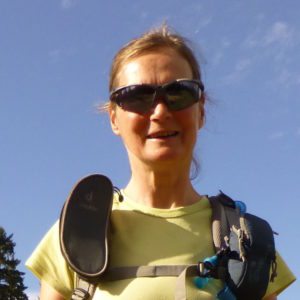
Written By
Diane McGuinness
Di lives in Chamonix in the French Alps and is a fully qualified International Mountain Leader and trekking guide. She has formidable knowledge of the mountains, culture and customs of the Italian Dolomites and Tour du Mont Blanc. She is also an enthusiastic connoisseur of Italian food and wine.

